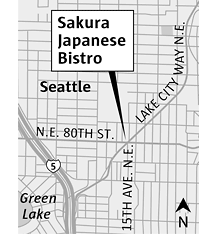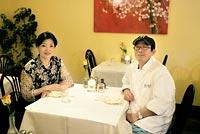Blossoming Sakura rolls out the alligator and more

There's no sushi bar. There's no teriyaki. And it really has the casual, comfortable, neighborhood feel of a "bistro." For that, you've got to hand it to Shinji and Sandy Kimura, who've stepped outside the bento box with Sakura Japanese Bistro.
In their cozy Maple Leaf storefront where Nat "King" Cole croons a constant tune, the Kimuras toy with fine-dining ambiance while welcoming calls for takeout. They'll amuse your kids with crayons and drawing paper while gifting you with an amuse-bouche — a welcome snack that allows time to peruse their lengthy menu.
"Small plates," "large plates" and sushi offerings are among the Japanese-accented options that make this newcomer a great place to grab a casual meal or spend a leisurely evening dining out.
Sakura translates as "cherry blossom," and that floral theme extends to tables prettily appointed with a single rose. That theme is echoed in the artwork and again when freshest seafood is presented as a sashimi flower.
Sandy Kimura directs a staff that is young and earnest — if not always able to answer every question with authority, they'll find out. Listen closely as they introduce you to the evening's specials, which often include some terrific finds: hamachi kama (broiled, delectably bony yellowtail "collar"); generous slices of wild, buttery, bluefin tuna; or such creative sushi rolls as the "Chinese roll" whose fried center sprouts cilantro and mushrooms.
Uncertain about sake? There's a brief, well-annotated list. Need menu suggestions? The staff is up to the task. "Have the alligator!" they'll insist. Chef Shinji wrestles that gator into submission in a dish reminiscent of a fried-chicken Caesar — were you to substitute meaty alligator for milder chicken breast and mixed greens for romaine ($19.50). Think of this as a novelty item: one that goes down easy and gives you bragging rights.
Chef Shinji's 35-year restaurant career began with an apprenticeship in Osaka, took him on a tour of high-end hotel kitchens in Asia, Europe and the U.S. and eventually brought him to Seattle. Thrilled to finally have a place to call his own, he regularly steps out of his kitchen to greet guests, bowing warmly and chatting in Japanese with those who share his native tongue.
Sad to say, I couldn't get any of my guests to order his miso-marinated beef tongue — or his tripe. They preferred instead a wintry stew of chewy-good beef on the bone, brazenly flavored with fresh ginger. They made short work of dishes more suitable to the American palate: crisp tempura vegetables; skewers of gently grilled shrimp; and irresistible Manila clams steamed with herbs, sake and butter.
More adventurous diners might appreciate thick slices of marinated Japanese eggplant showered with spicy togarashi and dried bonito flakes — which lend smoky flavor to the purple fruit. Fans of calamari steak should opt for ika matsukasa yaki — a slab of tender white squid, scored to tenderize it and to better catch its soy-kissed sauce. Oshinko moriawase (Japanese pickles) are common enough in local restaurants, but few chefs pickle their own. Try these here and you'll thrill to a nightly-changing assortment of crunchy vegetables that might include whole pearl onions, wrinkled baby eggplant and carrotlike burdock root.
After multiple visits, I've learned that the best way to navigate this menu is to nosh my way through it. I prefer to take advantage of the chef's excellent sushi rolls and share the not-so-"small plates" described previously ($4.50-$10) — including his colorful sashimi moriawase (five different types of thick-cut fish). But I've found it best to choose carefully among the entree-size offerings as they're less exciting and occasionally disappointing.
Salmon kuwa-yaki ($15), advertised as marinated and grilled, tasted farmed and steamed. Grilled Ghengis Khan Yaki ($17) arrived as a sizzling platter of tough lamb slices, onions and cabbage with an undistinguished Cognac sauce. And Tenzaru ($12) offered moist, crisp tempura shrimp, cold buckwheat noodles and a vapid dipping sauce.
Save for the green-tea ice cream, I'd also think twice about dessert. The "seasonal shortcake" was an achingly sweet block of layer cake and jelly. The red-bean soup a funky, clunky porridge. And the Japanese-style gelatin (offered gratis to my young son) bore a striking taste-resemblance to Grape Nehi.
Instead, treat yourself to an oyster shooter ($5). Listed among the sakes, this is my idea of a nightcap: a fresh oyster, raw quail's egg and minced scallion suspended in a shot glass with citrusy ponzu and sake. Kampai!
Nancy Leson: 206-464-8838 or taste@seattletimes.com. More reviews at www.seattletimes.com/restaurants.
Sample dinner menu
Small sashimi assortment $8.50
Agedashi tofu $5
Japanese pickles $6
Chinese sushi roll $7
Deep-fried alligator $19.50
Wafu-style pork spareribs $18.50

8014 15th Ave. N.E., Seattle; 206-524-4296
Web site: www.sakurabistro.com
Japanese
$$
Reservations: accepted.
Hours: dinner 4:30-9:30 p.m. Tuesdays-Thursdays, 4:30-10 p.m. Fridays-Saturdays, 5-9 p.m. Sundays.
Prices: salads $4-$8.50, small plates $4.50-$12, entrees $14-$19.50, sushi rolls $3-$9, sushi nigiri $2.50-$4.50 per pair, children's meal $5.50.
Drinks: A brief, well- annotated and modestly priced wine list, the usual Japanese beers plus a short, careful selection of sakes.
Parking: large gravel lot behind building.
Sound: soothing.
Who should go: Bistro fans with a yen for Japanese food. Those looking to step outside the bento box and go beyond tempura and teriyaki.
Wine, beer, sake / credit cards: AE, DISC, MC, VC / no smoking / no obstacles to access.